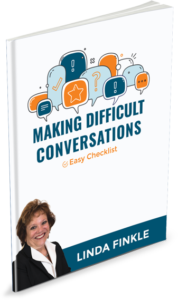Having conversations with staff where you are discussing performance that is unsatisfactory isn’t fun.
No one wants to engage in those conversations, expecting the worst, and avoiding them at all costs. Too often any discussion about performance with staff or other struggling workers is packaged into an annual performance review.
Waiting till then doesn’t provide an opportunity for the employee to work on improving and will leave them feeling frustrated. Often this is the first time they were aware there was a problem. Instead, if handled well, these conversations can be used to shape discussions into action plans.
Here are 8 ways leaders can improve the way they deliver negative feedback.
Don’t wait.
Waiting till the annual performance review is too late. Whether you want to discuss a specific situation and how it was handled, accountability concerns or an ongoing issue, the time to have the conversation is when it happens.
Be specific.
I worked with a business owner who would stand outside an employee’s office and tell them how they screwed something up, and then walk away. Of course, it was demeaning to the employee to be chastised in public, but if he wanted to improve performance this didn’t help. They didn’t know what he wanted differently, only that he was unhappy.
Take the time to be specific. If your concern is accountability be prepared to discuss specific examples, and explain what you want different. Should quality be the concern have examples you can discuss and specifics of how you want it handled in the future. Be as specific as you can be. Otherwise, how will they be able to perform to your standard and meet your expectations?
Know what you want as the outcome, and be ready to share.
Of course, it’s acceptable to express your disappointment or frustration, but so what. What do you want to happen at the end of the meeting, what’s the goal? You have to know this before you start the conversation, otherwise, you can’t communicate with someone else, nor is there an opportunity for improvement by the other person.
The outcome can be making sure they understand your expectations and a specific behavior you wanted changed, all the way to “here’s what will happen if nothing changes”. Know what you want before starting the conversation. Then at the beginning share it with the employee. It can be as simple as “I want to discuss my concerns about…, and how we are going to move forward”.
Get their perspective.
It’s important to get their perspective so the conversation is that, a conversation and not a monologue. Listen to what they have to say and work to understand their viewpoint. This isn’t about allowing them to make excuses and accepting them. They may provide information that you weren’t aware of that could influence the next steps.
What if you learned that a medical issue was the reason they were off work so often, coming in late/leaving early? Perhaps they don’t understand something as well as they thought and were afraid to tell you. Their perspective, the information they share is important for you to seek out. You may learn something and they will feel heard, even if it doesn’t change the course you had outlined already.
Ditch your assumptions.
You have to enter these conversations with an open mind and a willingness to be flexible. Too often we attribute problems to attitude, and in a discussion attack their attitude. Maybe the problem stems from not enough training, or they are tackling something beyond their skill level or they don’t know who to ask for help…it could be any number of things that aren’t related to attitude.
Ditching your assumptions also means letting go of you thinking there is only one way to solve the problem, change future outcomes, etc. Listen to your employee, they may have a different, even better way to resolve than what you had considered.
Use it as an opportunity to teach, not a lecture.
Too often these conversations are lectures. “Let me tell you what you did wrong or where you messed up or how awful your presentation was…” It’s similar to yelling at your kid for the umpteenth time to clean their room and reminding them how often you have had this same conversation. Instead of lecturing, use this conversation as a time to teach, mentor, and guide.
Develop a path forward together.
Discuss options for change and improvement. Work together to determine action steps, milestones, and success metrics. Even if you have already determined the steps, milestones, and metrics before the conversation, let them be involved with developing them. Your input and guidance can ultimately direct them where you want them to go.
Keep the conversation going.
It’s not enough to have the conversation once and move on, never to address it again. Build-in routine checkpoints so you can update them on their progress, and give input as needed. They deserve to know how they are performing if you are seeing progress and where they are against the established action steps and milestones. You have to reinforce the positive steps they are taking and the progress you are seeing. You also have to take the time to redirect if they are still off course.
Difficult conversations are uncomfortable for everyone. We don’t know how to handle them, we assume they will go poorly and expect that nothing will change anyhow so why bother. That doesn’t have to be the case.
Download our Making Difficult Conversations Easy Checklist. You’ll get a step-by-step approach to deliver the message you want, and tips to keep your emotions in check.









